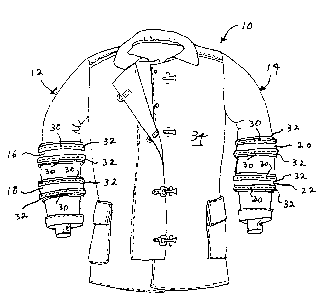Some of the information on this Web page has been provided by external sources. The Government of Canada is not responsible for the accuracy, reliability or currency of the information supplied by external sources. Users wishing to rely upon this information should consult directly with the source of the information. Content provided by external sources is not subject to official languages, privacy and accessibility requirements.
Any discrepancies in the text and image of the Claims and Abstract are due to differing posting times. Text of the Claims and Abstract are posted:
| (12) Patent: | (11) CA 2188356 |
|---|---|
| (54) English Title: | FIREFIGHTER'S GARMENT WITH THREAD PROTECTOR |
| (54) French Title: | VETEMENT DE POMPIER AVEC PROTECTION DES FILS DE COUTURE |
| Status: | Expired and beyond the Period of Reversal |
| (51) International Patent Classification (IPC): |
|
|---|---|
| (72) Inventors : |
|
| (73) Owners : |
|
| (71) Applicants : |
|
| (74) Agent: | |
| (74) Associate agent: | |
| (45) Issued: | 2002-08-13 |
| (22) Filed Date: | 1996-10-21 |
| (41) Open to Public Inspection: | 1998-04-21 |
| Examination requested: | 1998-10-08 |
| Availability of licence: | N/A |
| Dedicated to the Public: | N/A |
| (25) Language of filing: | English |
| Patent Cooperation Treaty (PCT): | No |
|---|
| (30) Application Priority Data: | None |
|---|
A piece of trim having a hard finish is disposed
adjacent the outer surface of the outer shell which is
formed of fire retardant material. A thread protector is
disposed adjacent the outer surface of the trim, and a
thread forming a line of stitching extends through the
thread protector, trim and shell to hold the trim in place.
The thread includes exposed portions, and the thread
protector is formed of soft material and extends away from
opposite sides of the exposed portions of the thread. The
thread protector also is spaced from the outer surface of
the trim a greater distance than the tops of the exposed
portions of the thread so that if an object approaches the
sides of the exposed portions, it will first contact an
edge of the thread protector and cause the thread protector
to fold over the exposed portions of the thread to prevent
abrasion thereof.
Bout de bordure à fini dur placé à côté de la surface extérieure de l'étoffe extérieure formée d'un matériau ignifugeant. Un protecteur de fil est contigu à la surface extérieure de la bordure. Un fil, formant une ligne de couture et comprenant des parties exposées, traverse le protecteur de fil, la bordure et l'enveloppe pour tenir la bordure en place. Le protecteur de fil, formé d'un matériau mou, se prolonge de chaque côté des parties exposées du fil. Il est aussi plus éloigné de la surface extérieure de la bordure que les sommets des parties exposées du fil de façon que, si un objet approche les côtés des parties exposées, il touchera en premier le bord du protecteur de fil et le forcera à se replier par-dessus les parties exposées du fil pour empêcher l'usure de ce dernier.
Note: Claims are shown in the official language in which they were submitted.
Note: Descriptions are shown in the official language in which they were submitted.

2024-08-01:As part of the Next Generation Patents (NGP) transition, the Canadian Patents Database (CPD) now contains a more detailed Event History, which replicates the Event Log of our new back-office solution.
Please note that "Inactive:" events refers to events no longer in use in our new back-office solution.
For a clearer understanding of the status of the application/patent presented on this page, the site Disclaimer , as well as the definitions for Patent , Event History , Maintenance Fee and Payment History should be consulted.
| Description | Date |
|---|---|
| Revocation of Agent Requirements Determined Compliant | 2021-04-01 |
| Time Limit for Reversal Expired | 2016-10-21 |
| Letter Sent | 2015-10-21 |
| Inactive: IPC from MCD | 2006-03-12 |
| Inactive: Late MF processed | 2004-10-28 |
| Letter Sent | 2004-10-21 |
| Grant by Issuance | 2002-08-13 |
| Inactive: Cover page published | 2002-08-12 |
| Inactive: Final fee received | 2002-05-27 |
| Pre-grant | 2002-05-27 |
| Notice of Allowance is Issued | 2001-12-18 |
| Notice of Allowance is Issued | 2001-12-18 |
| Letter Sent | 2001-12-18 |
| Inactive: Approved for allowance (AFA) | 2001-12-03 |
| Amendment Received - Voluntary Amendment | 2001-09-27 |
| Inactive: S.30(2) Rules - Examiner requisition | 2001-04-02 |
| Letter Sent | 1998-11-04 |
| Inactive: Application prosecuted on TS as of Log entry date | 1998-11-03 |
| Inactive: Status info is complete as of Log entry date | 1998-11-03 |
| Request for Examination Requirements Determined Compliant | 1998-10-08 |
| All Requirements for Examination Determined Compliant | 1998-10-08 |
| Application Published (Open to Public Inspection) | 1998-04-21 |
| Inactive: Entity size changed | 1998-03-31 |
There is no abandonment history.
The last payment was received on 2001-10-10
Note : If the full payment has not been received on or before the date indicated, a further fee may be required which may be one of the following
Patent fees are adjusted on the 1st of January every year. The amounts above are the current amounts if received by December 31 of the current year.
Please refer to the CIPO
Patent Fees
web page to see all current fee amounts.
Note: Records showing the ownership history in alphabetical order.
| Current Owners on Record |
|---|
| GLOBE MANUFACTURING COMPANY |
| Past Owners on Record |
|---|
| J. ROBERT BOWMAN |